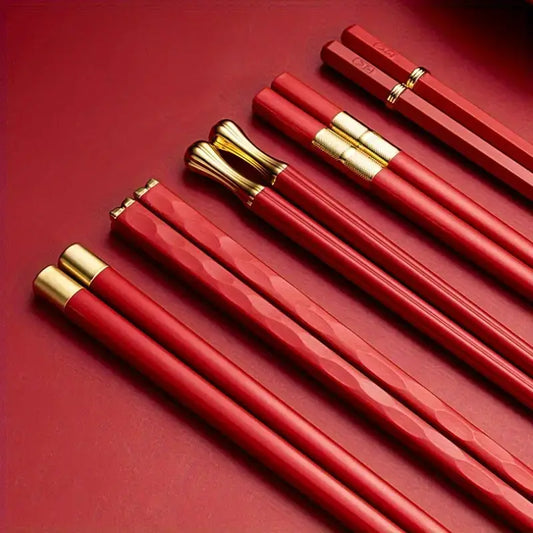Bold Tradition: Red Chopsticks
Red chopsticks carry a vibrant, powerful energy that bridges traditional symbolism and bold aesthetics. With roots deep in East Asian culture, red has long represented celebration, prosperity, strength, and luck. Red chopsticks embody this spirit at the dining table—commanding attention while honoring heritage.
From lacquered wooden varieties to modern matte finishes, red chopsticks are ideal for both ceremonial and everyday use. Their dynamic presence enhances everything from family dinners to formal banquets, inviting a festive, auspicious atmosphere wherever they appear. Their vivid hue often plays beautifully with contrasting table settings, drawing the eye while enhancing the visual texture of a meal.
For food stylists and hospitality experts, red chopsticks are prized not only for their cultural resonance but for the emotional responses they evoke—passion, appetite, and reverence. They transform the act of eating into a multisensory experience steeped in color psychology and spiritual symbolism.
Cultural Significance of Red
In many Asian cultures, red is the color of good fortune, energy, and life. In Japanese tradition, red is associated with protection and purification. Red torii gates, for example, signify sacred space. At the dinner table, red chopsticks extend this symbolism to nourishment, familial bonding, and gratitude.
Red is also prevalent in wedding ceremonies, New Year festivities, ancestral offerings, and even rites of passage. As dining implements, red chopsticks are used to convey sincerity, celebration, and honor. In China, they’re often part of bridal dowries or wedding gifts, symbolizing a blessed and prosperous union.
In Buddhist and Shinto customs, red items—particularly during meals—represent the life force and the desire to protect sacred connections between people, food, and spirit. When used at formal meals or temple ceremonies, red chopsticks serve as a bridge between the earthly and the divine.
Even in modern times, red continues to play a prominent role in pop culture, holiday design, and traditional decor. Using red chopsticks keeps this ancient symbolism alive, while also grounding meals in the present moment.
Materials and Style Options
Red chopsticks are available in a diverse range of materials, each with its own character and appeal:
| Material | Description |
|---|---|
| Lacquered Wood | Traditional style, smooth feel, deep crimson tones with polished surfaces |
| Bamboo | Lightweight and eco-friendly with dyed or painted red finishes |
| Resin | Durable and vibrant; often used in modern sets with gradient tones or patterns |
| Ceramic | Elegant, cool to the touch; often seen in high-end settings |
| Hybrid Designs | Red handles combined with black, gold, or silver metal tips |
Design variations include:
-
Gold Foil Detailing: Dragons, phoenixes, waves, lotus flowers, or kanji for longevity
-
Etched Lacquer Patterns: Cranes in flight, mountain ranges, or family crests
-
Matte or Gloss Finishes: Ranging from bold scarlet to deep burgundy
-
Wedding-Themed Wraps: Red silk cords, knot-tie symbols, or cherry blossom paper sleeves
-
Collectible Editions: Seasonal sets, limited collaborations, or handmade artisan pairs
Each design not only adds aesthetic value but enhances the symbolic language of the chopsticks themselves.
When and How to Use Red Chopsticks
Red chopsticks make a statement—they're perfect for occasions with emotional, spiritual, or festive weight:
-
Weddings: Symbolize love, luck, and prosperity for the couple
-
New Year Celebrations: Usher in joy, wealth, and health
-
Family Gatherings: Emphasize warmth, togetherness, and generational respect
-
Temple Feasts or Memorials: Used with care and reverence to honor ancestors
-
Gift Sets: Presented in pairs to signify harmony and unity
-
Housewarming Parties: Represent protection, energy, and new beginnings
-
Restaurant Decor: Used to highlight regional heritage or special menu themes
Even outside of special occasions, red chopsticks can energize daily meals. When paired with earthy ceramics or muted linens, they become focal points. When paired with vibrant dishes—like spicy noodles, grilled meats, or sushi—they intensify the visual storytelling of the plate.
They're also ideal for food photography, catering events, or promotional materials where color harmony is crucial. Their ability to symbolize celebration and cultural richness makes them ideal for branding and hospitality design.
Care and Longevity
To maintain their richness and beauty, red chopsticks require mindful care:
Maintenance Tips:
-
Hand Wash Only: Especially for lacquered or painted versions; prevents dulling and peeling
-
Use Soft Sponges: Avoid abrasive scrubbers that can damage finishes or decorations
-
Dry Thoroughly: Red pigments, especially in wood or bamboo, are susceptible to fading with water exposure
-
Avoid High Heat: Do not microwave or expose to prolonged sunlight
-
Store Properly: Use sleeves, trays, or upright holders to protect shape and design
Many red chopstick sets include traditional storage options—such as silk-wrapped tubes, carved wood boxes, or brocade pouches. These help extend the life of your utensils while adding beauty and ritual to their use.
More Than Just Color
Red chopsticks are a sensory celebration. Their color stimulates appetite, honors tradition, and injects vibrance into mealtime. For some, they’re spiritual; for others, deeply nostalgic. But for all, they signify a meal worth remembering.
Their boldness invites confidence. Their legacy invites reverence. And their visual charm invites joy.
Why Red Chopsticks Matter:
-
Symbolize Luck and Life: Cultural icons for prosperity, energy, and vitality
-
Enhance Presentation: Striking color that elevates both traditional and modern dishes
-
Honor Cultural Roots: Anchor meals in centuries of ceremony and celebration
-
Ideal for Gifting: Carry deep symbolism when paired or boxed elegantly
-
Inspire Conversation: Guests often ask about their meaning, opening dialogue and cultural sharing
Bold in color. Rich in meaning. Red chopsticks are a feast for both hand and heart—an everyday tool imbued with timeless significance and a touch of ceremonial splendor



